Arrangement of a well with a caisson: phased instruction + analysis of technical nuances
The device wells at home solves the problem with uninterrupted water supply. But for this source to work properly, you need to correctly organize the entire process - from drilling a well to equipping it and putting it into operation.
With permanent residence in the house, the most reasonable solution is to equip the well with a caisson. This version has a lot of advantages, which you will learn about from our article. It will also discuss step-by-step project implementation.
The content of the article:
Benefits of a Caisson Well
With year-round use of the well, installation of a caisson at its mouth is indispensable. This enclosure is a waterproof chamber located in water-saturated soil. In terms of ease of maintenance and operation, a well with a caisson is the best option.
In addition to the caisson, integral elements of a water well are accumulatorsurface or submersible type, pipes, shutoff and control valves, if desired by the owners and the head.
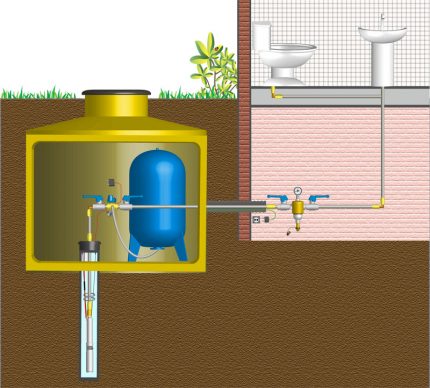
This solution has several advantages:
- All plumbing equipment is placed compactly in the chamber and it does not need to allocate a separate place in the house. As in the case of central water supply, only a pipe and a power cable for the pump will need to be brought into the house.
- If the house is designed exclusively for summer living, then to remove water from the water supply for the winter, you just need to open the drain tap located in the caisson.
- When you need to submit the input to several points on the site, then this idea is very simple to implement by withdrawing from the caisson the required number of pipelines.The process control is carried out by means of valves.
- A winch mounted in the upper compartment of the chamber will simplify the process of removing the pump from a deep well if it needs to be repaired or replaced.
- The camera will protect the downhole equipment located in it from freezing. If the caisson is installed correctly, you can not worry about the safety of its filling even at a temperature of -35 ° C.
Thus, in the presence of a caisson, adverse external factors will not affect quality in any way. home water supply.
The main requirement for the caisson is tightness. If this condition is violated, dirty water from the chamber may enter the aquifer through the casing. The pollution of the aquifer is unacceptable, therefore the well head and the caisson must always remain dry.

When calculating the height of this structure should be based on the depth of freezing of the soil. So that the caisson is guaranteed to be below this point, the size is taken equal to two meters. For the convenience of performing work inside the caisson, the diameter of the internal space should be within 1–1.5 m.
A chamber is made of metal, plastic, brick or reinforced concrete rings. In its bottom there is a place for fixing the structure on the casing. Pipes for removing pipes and cables are located in the walls. To provide convenient access to equipment, the caisson is often equipped with a ladder. The chamber is sealed with a sealed cover.
Step-by-step installation instructions
It all starts with choosing a place for the well and choosing arrangement methods source of water.
The technology for arranging a water supply source consists of a series of sequential and crucial steps:
- Well. The first of the stages is the drilling of the well itself.
- Caisson. The second step is to start the installation of the caisson.
- Warming. The third stage is that they fill the foundation pit with earth to the very cover, then the hatch is insulated.
- Installation of equipment. Stage four - after completion of work, installation of equipment is started, which should ensure uninterrupted and efficient water supply to the house and to the site.
The installation process of the caisson structure also consists of several operations.
Consider the main ones:
- A hole is made in the bottom of the caisson with a slight shift from its center for the subsequent installation of the sleeve under the casing. The diameter of the sleeve should exceed the corresponding parameter of the pipe, measured along the outer contour, by 10-15 millimeters.
- In the side walls of the caisson, pipes are welded under the water pipes and cable.
- Dig a pit in such a way that the neck after installation is completed, rises above the ground by no more than 20 cm. For the convenience of connecting the chamber to the casing, the diameter of the pit should be 0.2-0.3 m larger than its own appropriate size.
- Cut the casing string at ground level.
- Lay supports on the foundation pit in the form of bars. A caisson is placed on them.
- The casing is joined with the caisson sleeve, the structure is adjusted horizontally, and then hermetically welded.
- The bars are removed from under the chamber, lowered into the well.
- Insert the pipe into the appropriate nipples, cable.
The water in the newly drilled well is always dirty, therefore, to clean it pump. Drillers are advised not to use equipment purchased for continuous use for this purpose. The cheapest temporary pump will do just fine with this job, and when the well is shaken, a permanent one can be launched.

It should be noted that the installation of a protective container such as a caisson is not always necessary. It happens that a room suitable for placing equipment is already available in the zone where the well is located.
In this case, a more rational solution would be to use it for its intended purpose and save on installation of the caisson.
Features of the choice of equipment
The basic elements of equipment for a well are:
- pump;
- hydro-pneumatic accumulator;
- head end.
The main type of equipment is a pump. Both surface and submersible pumps are suitable for the well. The first type of equipment is used for wells of relatively shallow depth - up to 10 m, the second - for deeper ones.
An important point is to configure the automatic operation of the well equipment. It is performed in tandem from pressure switch and a hydraulic tank. The operating pressure parameters are accepted according to the factory settings or produced by relay adjustment in accordance with the requests of the owners.

Let us consider in detail each of the main devices, their role in the circuit and the assigned functions.
Step No. 1 - we select the optimal type of pump
Surface pumps are designed for surface mounting. In the case of a well with a caisson, they are placed directly in the chamber. With the installation of such equipment there is no difficulty, such pumps are simple to maintain.
Depending on the design, surface pumps are vortex and centrifugal. The first of them are used to lift water from a shallow depth, and the second can overpower 10 m.
Outdoor pumping equipment usually goes on sale already equipped with automation that controls its on and off. Availability in the water supply network pumping station provides a stable working head.
When choosing a surface pump, you should check if there is such a function as dry run protection. Otherwise, if the water level in the well falls, the pump may fail.
Submersible pumps are lowered directly into the well. They allow you to extract water from great depths. Manufacturers sometimes equip such units with float switches, insuring them against breakage, if the water mirror in the well drops very low.
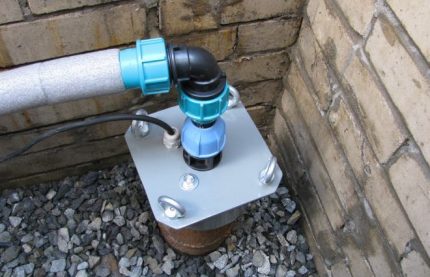
Expensive options for surface-type equipment have special filters, so they can pump water in which solid impurities are present.
Choosing a deep pump for your water supply, you should not lose sight of such a parameter as its diameter. There are different models, some can be used with a rather large diameter of the well, then they simply will not enter the well with a small cross section.
The cost of equipment from this category is quite high, but there is also a price plug. Models in a stainless steel case are more expensive, products in a plastic case are cheaper.
The best performance for submersible pumps, but in addition to this parameter, you must also take into account the length of the drain. The larger it is, the higher the pressure in the system.

The size of the downhole pump is also important. The cylinder cross section should be 2-3 cm smaller than the corresponding casing size. Therefore, it is necessary to choose a pump so that it meets the power requirements, but at the same time does not go beyond the permissible sizes.
Step No. 2 - a hydraulic accumulator for a well
The purpose of the accumulator is to perform a smooth start and stop of pumping equipment as needed in water. In addition, this equipment maintains an established minimum of circulating water in the system and prevents water hammer.
This device in the water supply system performs the same role as the compensation tank in the heating system. In himself, in his normal state, a certain amount of water is always present under stable pressure. Its presence in the system guarantees slower wear of pumping equipment, since it is switched on less frequently.
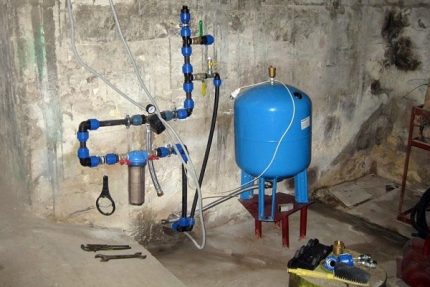
The material from which the accumulator casing is made, as well as its individual elements, does not react with water, and therefore does not affect its quality in any way. At the heart of principle of operation of a hydraulic tank lies the use of compressed air. It is pumped under a pressure of 1.5–2 atm between the casing and the rubber membrane.
The workflow consists of the following steps:
- air under pressure acts on the membrane when opening the tap;
- the membrane is compressed and displaces fluid through the outlet valve;
- the inlet valve opens when the volume of water reaches its minimum and the cavity begins to fill again with water;
- the process is repeated from zero position.
There are two types of this equipment according to the installation method: vertical and horizontal. If you have to choose between these two types, you should know that the valve for venting excess pressure in the vertical unit is at the top. The whole process happens automatically.

To remove air from a horizontal structure, an auxiliary pipe equipped with a drain or ball valve is required. It requires human intervention.
Step # 3 - the head in the well design
This element of the well (head) refers to protective equipment. Mount it at the top on the end of the borehole pipe.
Its task is to protect the wellhead from foreign objects, pollution. It also serves as a support for hanging pumping equipment. It also hosts some devices.
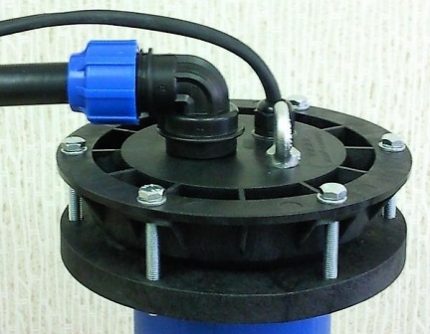
Perform protection from plastic or metal - steel or cast iron. The head made of plastic can withstand a load of up to 0.2 tons, metal - up to 0.5 tons.
Typically, the heads of wells with a depth of up to 50 m experience a small load. For deep wells, powerful pumping units, wires and heavy steel cables are used. To place all this, you need a metal head.
With rules and technology well head installation do it yourself will familiarize you with the article we recommend.
Important points when arranging
Given some technical nuances, you can significantly save on the arrangement of a well equipped with a caisson. For example, use a factory-made caisson.
If you position the well closer to home, then:
- earthworks will decrease;
- fewer pipes needed;
- you will need a pump of small capacity, sufficient only to raise water to the surface.
You can save when choosing a drilling method. To make a well for personal use, work can be done using a hand drill. Sometimes they use an electric tool, percussion devices.
Caveat # 1 - Choosing a Well Drilling Method
When choosing a specific tool, you need to proceed from the characteristics of the soil. With self well drilling manual method will have to make considerable efforts, but under favorable conditions, you can get to the aquifer, lying at a depth of 15 m.
It is recommended to make no more than five revolutions of the drill in one pass, otherwise it will be difficult to extract.

A small depth well can also be drilled with a screw. Its rotation is carried out both manually and using mechanisms. In any case, a tower is built over the future well in the form of a tripod to facilitate the lifting of the tool. When choosing the second method, you will also need an electric motor suitable for power.
For well logging, a shock-rope method is also used. The working tool here is a pipe, the edges of which are sharpened sharply (a driving glass with a strong edge along the lower edge). Due to its considerable weight, it crashes into the ground with great effort, then it is removed using a rope system and freed from the ground.
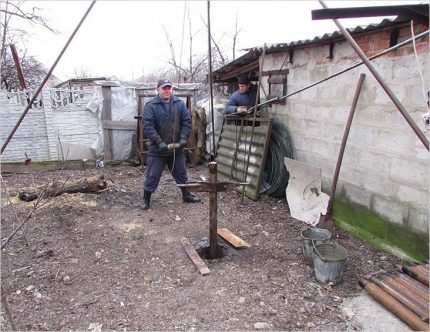
The casing (pipe) is taken a little larger in diameter than the length of the pipe called a glass. It should be set strictly observing the verticality. This is important with any method of drilling. If this nuance is neglected, soils can collapse.
Experts advise using PVC pipes with a cross section of 12.5 cm. The first pipe is lowered after passing one meter. Further, the length of the casing is added as it goes deeper. Connect the segments using thread on the ends of the pipes.
Nuance # 2 - the secrets of drilling a well
You can drill a well in any season, but the complexity of the work will be different. The worst option is spring. Groundwater is at the highest level during this period. In such conditions, it is difficult to determine the location of the main aquifer.
The installation of the well in the summer is considered the best option, because the water level is stabilizing and its location is easy to determine. In autumn, the best month to carry out these works is September. At this time, usually the rainy season does not yet begin, the aquifer can be determined without difficulty.
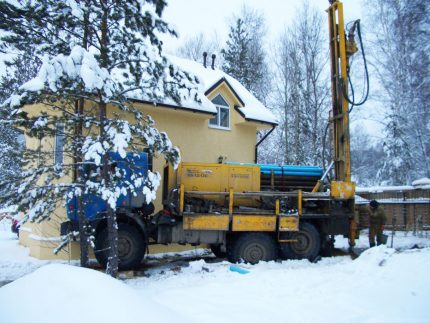
In winter, you can drill a well until the temperature drops below -20 °. Due to freezing of the soil, the walls of the well are insured against collapses. Groundwater is at a minimum.
Nuance # 3 - the optimal material for the caisson
There are several types of caissons:
- from reinforced concrete rings;
- metal;
- plastic;
- brick.
Reinforced concrete rings and bricks. This type of caissons practically does not provide tightness for a long time. This threatens the equipment with flooding and subsequent loss of performance.
Metal. If all the requirements were met during the manufacture of metal caissons, they will have good tightness.
Earth in relation to metal is an aggressive environment, therefore, the enclosing structures of such chambers are subject to oxidation, as a result of which depressurization can occur.
Plastic. The caissons made of polymeric materials are convenient, lightweight, easy to install and operate. The probability of depressurization is rather small, because material is not subject to corrosion. Plastic caissons serve much longer than metal ones.
Conclusions and useful video on the topic
Construction of a well with a concrete caisson:
Visual aid for the installation of the caisson and equipment for the well:
DIY installation of a well is a responsible and time-consuming process. Performing work competently is possible only with certain knowledge and skills. But nothing is impossible, the key to success is the right approach and careful preparation.
It is necessary to adopt a key rule: there are no minor nodes in the device of the well. If at some point it is problematic for you, entrust the experts to resolve the issue so that you do not have to equip a new well later.
Tell us about how you built a caisson over the wellhead in a suburban area with your own hands. Share technological nuances that are useful to site visitors. Please leave comments in the block below, ask questions, post a photo on the topic of the article.

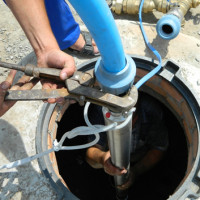 Do-it-yourself water well setup: how to properly equip a water source
Do-it-yourself water well setup: how to properly equip a water source 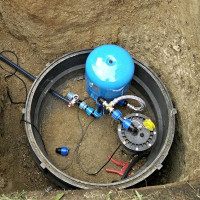 How to arrange a well without a caisson: an overview of the best ways
How to arrange a well without a caisson: an overview of the best ways  Arrangement of a water supply system at a dacha from a well: schemes, nuances, an overview of the necessary equipment
Arrangement of a water supply system at a dacha from a well: schemes, nuances, an overview of the necessary equipment 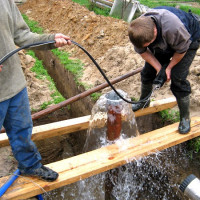 Do-it-yourself flushing of the well after drilling: step-by-step briefing on the work
Do-it-yourself flushing of the well after drilling: step-by-step briefing on the work 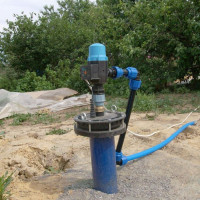 The head for the well: device, types of structures, installation and installation rules
The head for the well: device, types of structures, installation and installation rules 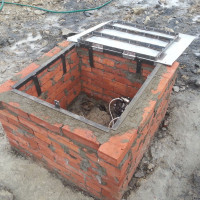 How to make a caisson for a well with your own hands: device options and methods for their implementation
How to make a caisson for a well with your own hands: device options and methods for their implementation  How much does it cost to connect gas to a private house: the price of organizing gas supply
How much does it cost to connect gas to a private house: the price of organizing gas supply  The best washing machines with dryer: model rating and customer tips
The best washing machines with dryer: model rating and customer tips  What is the color temperature of light and the nuances of choosing the temperature of the lamps to suit your needs
What is the color temperature of light and the nuances of choosing the temperature of the lamps to suit your needs  Replacement of a geyser in an apartment: replacement paperwork + basic norms and requirements
Replacement of a geyser in an apartment: replacement paperwork + basic norms and requirements
And which accumulator is better to take, no one knows? I just look at the volume, but I would like it to turn out not very expensive at a price. I understood from the text that the accumulator material does not play a role, but what about the volume? Which option will be the most optimal? Yes, and it’s difficult to determine the material of the caisson, although I still think about stopping on plastic.
I will try to answer your questions in more detail. As for the volume of the accumulator, in this case a tank of 20 liters is required at least. I think that this volume will be enough for the accumulator to correctly perform its functions: water supply, reducing the number of pump on / off, protection against water hammer. If you need a larger supply of water, then there is an option to consider tanks of 40 liters or more.
This is if we are talking about buying a hydraulic accumulator, but no one bothers you to weld the expansion tank yourself from metal plates. Thus, you will save on the purchase and get the necessary volume. Metal is the most optimal material for a hydraulic accumulator.
For the caisson, the main requirement is tightness, this must be carefully monitored at the installation stage. You may well use molded plastic case products for these purposes.
I would also build attention on the casing sleeve. I used to get ground water into the well through it. Now they have put a caisson made of plastic Bio-S - in it the coupling has the construction of a collet clamp, with a rubber ring in a conical recess. Clamp, and the cone gum seals the connection. The coupling is tight, holds.